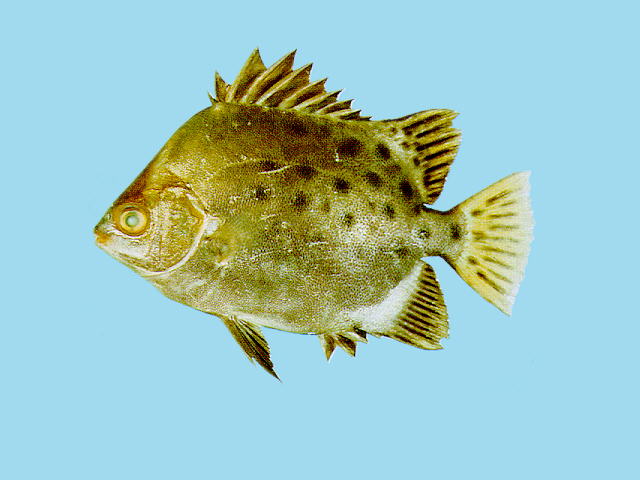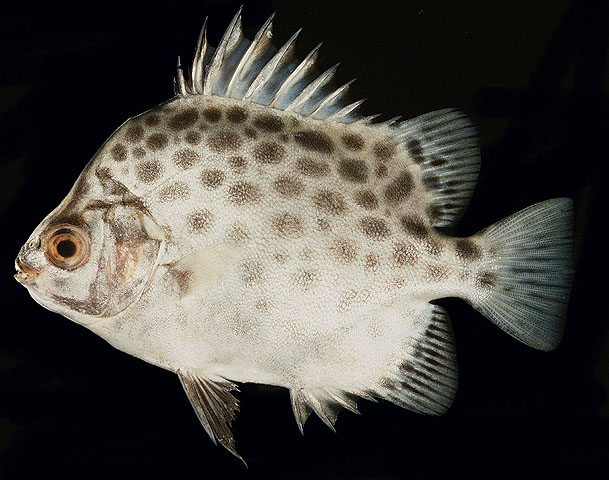Scatophagus
argus
(Linnaeus,
1766)
Spotted scat
View all media / Upload your photos and videos
Expand all
Classification / Names
Teleostei (teleosts) > Acanthuriformes (Surgeonfishes) >
Scatophagidae (Scats)
Etymology: Scatophagus: Greek, skatophagos = feeding upon dung (Ref. 45335).
More on author:
Linnaeus.
Environment / milieu / depth range / climate zone / distribution range
Distribution
Maps

Scatophagus argus / Native range
AquaMaps Data sources:
GBIF
OBIS
This map was computer-generated and has not yet been reviewed.

Scatophagus argus / Suitable habitat
AquaMaps Data sources:
GBIF
OBIS
This map was computer-generated and has not yet been reviewed.

Scatophagus argus / Point map
AquaMaps Data sources:
GBIF
OBIS
This map was computer-generated and has not yet been reviewed.

Scatophagus argus / Year 2050
AquaMaps Data sources:
GBIF
OBIS
This map was computer-generated and has not yet been reviewed.
Length at first maturity / Size / Weight / Age
Short description
Dorsal spines (total): 10 - 11; Dorsal soft rays (total): 16 - 18; Anal spines: 4; Anal soft rays: 13 - 15. Ground colour greenish. Juveniles with a few large roundish blotches, about size of eye, or with about 5 or 6 broad, dark, vertical bars. In large adults, spots may be faint and restricted to dorsal part of flanks. Body quadrangular, strongly compressed. Dorsal head profile steep. Eye moderately large, its diameter somewhat smaller than snout length. Snout rounded. Mouth small, horizontal, not protractile. Teeth villiform, in several rows on jaws (ref 43044).
Biology
Inhabit harbors, natural embayments, brackish estuaries and the lower reaches of freshwater streams, frequently occurring among mangroves. Feed on worms, crustaceans, insects and plant matter (Ref. 7020, 44894, 48637). The dorsal, anal and pelvic spines are believed by Philippine fishers to be venomous and capable of inflicting wounds (Ref. 6565). Used in Chinese medicine (Ref. 12166). In Hong Kong live fish markets (Ref. 27253). Marketed as fresh (Ref. 12693).
Life cycle and mating behavior
Multiple spawner (Ref. 102820).
Main reference
Allen, G.R. 1984 Scatophagidae. In W. Fischer and G. Bianchi (eds.) FAO species identification sheets for fishery purposes. Western Indian Ocean (Fishing Area 51). volume 4. [var. pag.]. FAO, Rome. (Ref. 3489)
IUCN Red List Status (Ref. 125652)
Least Concern (LC); date assessed: February 04 2009
CITES (Ref. 131153)
Not Evaluated
CMS (Ref. 116361)
Not Evaluated
Threat to humans
Venomous (Ref. 6565)
More information
- Countries
- FAO areas
- Ecosystems
- Occurrences
- Introductions
- Stocks
- Ecology
- Diet
- Food items
- Food consumption
- Ration
- Common names
- Synonyms
- Metabolism
- Predators
- Ecotoxicology
- Reproduction
- Maturity
- Spawning
- Spawning aggregation
- Fecundity
- Eggs
- Egg development
- Age/Size
- Growth
- Length-weight
- Length-length
- Length-frequencies
- Morphometrics
- Morphology
- Larvae
- Larval dynamics
- Recruitment
- Abundance
- References
- Aquaculture
- Aquaculture profile
- Strains
- Genetics
- Allele frequencies
- Heritability
- Diseases
- Processing
- Mass conversion
- Vision
- Pictures
- Stamps, Coins Misc.
- Sounds
- Ciguatera
- Speed
- Swim. type
- Gill area
- Otoliths
- Brains
Estimates based on models
Preferred temperature (Ref. 123201): 25.4 - 29.3, mean 28.6 °C (based on 2701 cells).
Phylogenetic diversity index (Ref. 82804): PD50 = 0.8125 [Uniqueness, from 0.5 = low to 2.0 = high].
Bayesian length-weight: a=0.03236 (0.02357 - 0.04442), b=2.92 (2.83 - 3.01), in cm total length, based on LWR estimates for this species (Ref. 93245).
Trophic level (Ref. 69278): 3.0 ±0.4 se; Based on food items.
Generation time: 0.9 ( na - na) years. Estimated as median ln(3)/K based on 1 growth studies.
Resilience (Ref. 120179): High, minimum population doubling time less than 15 months (K=0.97; tm=1; Fec=486,500).
Fishing vulnerability (Ref. 59153): Low vulnerability (20 of 100).
Price category (Ref. 80766): Low; Questionable: based on ex-vessel price for species in this genus.
Nutrients (Ref. 124155): Calcium = 80.7 [40.4, 127.3] mg/100g; Iron = 0.8 [0.5, 1.4] mg/100g; Protein = 19.2 [18.0, 20.3] %; Omega3 = 0.0919 [, ] g/100g; Selenium = 28.9 [14.3, 62.6] μg/100g; VitaminA = 22.8 [6.1, 87.4] μg/100g; Zinc = 1.49 [0.96, 2.24] mg/100g (wet weight); based on nutrient studies.










